
Lang Lang
Lang Lang was on the radio this morning (his piano, not his presence). The English lady, Emma Ayres, hosts a fine, fine classic FM radio show, Teas on Toast, on ABC Radio. She played Lang Lang's Haydn sonata in Carnegie Hall, 2003. Lang Lang, 27, is the pride of modern day Mainland Chinese. His reputation spread so rapidly that a Chinese-language biography appeared before his 17th birthday. I have no business joining the band wagon in praising him. But I can feel his sensibility through his fingers (the fastest fingers in the whole of China, his fans will have you believe).
He comes from Sheng-Yang in the far north of China. Whenever I think of northern China, I think of the noodles they have and the hot steam buns they have. They always say that the north has wheat and the men grow tall up there (and ride horses!); and the south has rice. My father comes from the border line between the north and the south in Mainland China, so we ate both noodles and rice at home when I was growing up. My father's favourite Sunday lunch was noodles with the best quality soy sauce one could find. Can you imagine fresh pasta with the best quality olive oil you can find; it is like that. Plain, with nothing else on, the flavour of flour comes "shining through" (to borrow James MacGuire's words) in freshly boiled noodles.
We kids didn't appreciate that.
So, on the way driving home from dropping the kids to school this morning, I thought to myself - Lang Lang, I am going to do a steam bun today, my version. You watch.
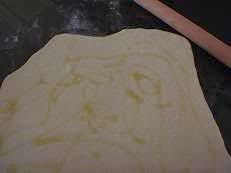
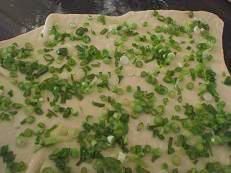
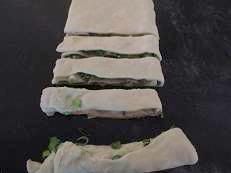


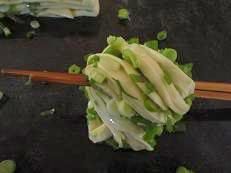
- Roll the dough (formula below) out to about 1/2 to 1 cm thickness. Sprinkle some olive oil and salt on top (a couple of drops of sesame oil would be GRAND), spreading it evenly, and
- Sprinkle the chopped shallots.
- Fold 1/3 of the dough to the center, then the other 1/3 to the center like folding a letter (the dough now has 3 layers). Slice the dough one inch width apart.
- Place two pieces on top of each other (ie, six layers in total).
- With the help of two chopsticks, press the dough down to the bottom to make indentations.
- Slide the chopsticks underneath the dough, lift the dough up, then twist the dough
I made some smaller ones with just three layers too:


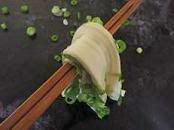
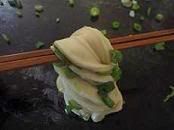
My formula: this is just any white bread dough; it should pass windowpane test; let it rest for 3o minutes up to an hour before rolling it out as above.
- 300 g white flour
- 168 g water
- 24 g olive oil
- 10 g sugar
- 6 g salt
- 3 g instant dry yeast (the reason for this is because this is meant to be a quick rising dough)
- a big bunch of shallots, chopped up
- some olive oil (and sesame oil if you wish)
- some more salt
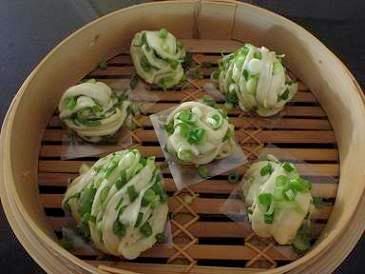
dough resting after shaping
Let this rest for 3o minutes up to an hour again. Bring a big pot of water to boil; THEN, place the steamer on top of the boiling water. The dough will expand rapidly in steaming temperature. After 5 minutes, turn the heat down to medium. Boil another 7 minutes. Total steaming time 12 minutes. And there we have it:
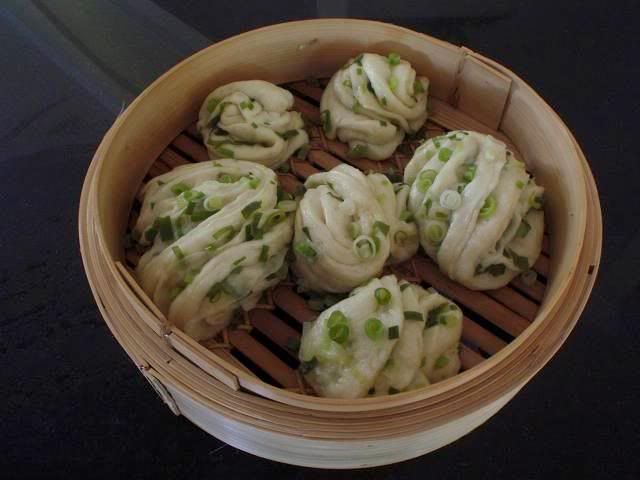
Chinese Shallots Steam Buns
I can imagine diners in a northern Chinese tea parlour very happily ordering these shallots steam buns for their Sunday brunch, followed by a pot of tea over some gossip.
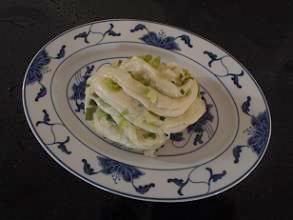
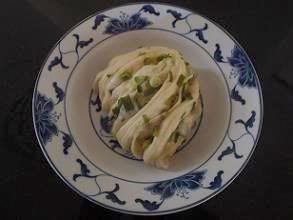
Shiao-Ping
p.s. Lang, the first word of his full name, is his family name, which is not a common one among Chinese. Lang, the second word of his name, is a completely different Chinese character which pronounces the same as the first character. His name reads very poetic to a Chinese literary mind. Many Mainland Chinese names today still retain that poetic-ness about them, whereas the names of Chinese from other parts of the world, especially, those from Taiwan, are as ... oh what should I say...; girls' names denoting beauty, virtue, chastity, etc, and boys' names effecting courage, loyalty, righteousness, and the like, are very common; and for both girls and boys, wealth and fortunes are a forever welcome theme for names.


Comments
Thank you for sharing your inspiration and the beautiful results.
You have told us about other recipes using "shallots." What I see in your photos are what I would call "scallions" or "green onions."
What I call "shallots" look like this:
Do you know this vegetable, and do you have a different name for it?
David
... is called differently in Australia - shallots. Pamela and I have been through that discussion and we've found it's called by different names in at least three continents, very confusing:
http://www.thefreshloaf.com/node/12491/chinese-sourdough-bread#comment-72164
http://www.thefreshloaf.com/node/12491/chinese-sourdough-bread#comment-72523
Shiao-Ping
Hi, Shiao-Ping.
I missed that discussion. What Pamela said corresponds to the terminology to which I am accustomed.
Thanks for the links. I will now question the kinds of veggies called for in recipes from other countries.
David
... red skin and quite small (roughly 5 cm in diameter or smaller)?
Shiao-Ping
p.s. There are "onions" that look like those in your picture, red skin, but much bigger, as big as normal "onions" which are white skin.
Hi, Shiao-Ping.
The photo above is of what we call "shallots." I believe that your are referring to is what we call "red onions." The skin on red onions varies from a light red color to a dark, purplish color.
David
Shiao-Ping
If you don't eat them all right away after steaming, how do you store them?
Just steam them as normal, then let them cool, wrap them, and freeze them. To heat them, just pull them out and pop them back in the steamer for 10-15 minutes to warm them up.
To heat them again, I sometimes just pop them in the microwave for 30 seconds for my kids. Re-steaming will get the best result if you don't mind the trouble. Microwave tends to dry them out very fast if they are not consumed straight away.
Absolutely gorgeous! Suddenly I feel like making another batch of steam buns. Yum! :)
Nice looking steamed buns, Shiao-Ping. So, you served them plain? I think I would prefer some type of sauce. Can you recommend anything besides soy sauce?
--Pamela
Hmmm... I am not sure. Soy is the one I can think of straight away.
Oh, how about the sauce combo that Chinese use for having their little meat dumplings. It is:
Shiao-Ping
Thanks, I'll give it a try.
--Pamela
Thank you, Shiao-Ping, for sharing this recipe. There is no comparison with the beauty of your steamed buns, but mine are delicious! Undoubtedly I had too much oil on my dough; most of the onions squeezed right back out. And my dough was not rolled thin enough. I'll do better next time!
... when I posted those steam buns, I honestly did not think any one would try them! I did them as I did most of my other bakes like a theraphy, to kill time. But I had a smile on my face reading your description and imagining the onions being squeezed right out because of too much oil! You see in the small photos of my post there were a lot of onions/shallots scattering about too.
Can you think of a herb, a Western equivalent of the Chinese spring onions/shallots that we used here for the steam buns? Parsly? Corianda? Oh, oh, I just thought of something - if you mix parsly and basil, chop them up, mix in with a bit of olive oil and salt and use this mixture to spread on the thin bread dough - you've got an Italian Chinese Steam Buns ("Chinese" because steaming is a Chinese method not Italian method) - hehehehe!
(I know we all know what parsley looks like - I am just injecting green color into the space here.)
Oh, for that matter, why not just spread pesto sauce on the bread dough! (Or, serve the Italian Chinese Steam Buns with the pesto sauce!)
Shiao-Ping
p.s. Northern China has a steam desert called thousand layer cake. It uses a sweet paste (milk powder, deccicated coconut, flour, or even almond meal, sugar, and butter) to spread on the thin dough, then steam. It's one of my favorites. To do it well, the dough has to be rolled out quite thinnly - no more than 0.5 cm thickness, and you stack many layers on top of each other. They leave it as a big square shape (without twisting it), then when it's done, slice it as you would a cake. Or, instead of this sweet paste, they do a mixed fruits version with all the chopped colorful red and green glace cherries together with the usual dried fruits.
p.p.s. If you want to preserve the green color in the buns, try steaming for shorter time - like no more than 10 min.
My husband and son probably won't eat green onion steamed buns but I know they will eat the steamed char siu bao. I have a recipe yet I haven't tried it. Can't wait to see some more pictures of your creations.
Thank you Shaio Ping for this great steamed bun formula. I made these Sunday and they are lovely. Twisting seemed a little tricky but with the aid of having done Norm’s Double Knot rolls in the past the ones that started to misbehave just got a little tuck of the ends into the loop, and hurrah they stayed together fine. I was not able to get consistent sizes though, so I need to make more in order to practice.
East met West when I took a large one, sliced it length wise and with a little mustard and wasabi mayonnaise made a most amazing ham sandwich. Very unique textural experience. I took one of these to a friend who loved it. Today though I will have it with a Beef and Peppers dish. It will go well.
Have a good journey (I saw your 8.3.09 post). I enjoy your posts and look forward to more of your bread adventures. This is now a treasured formula for me. Sorry, no photos.
Thanks again.... and bake on.
Dosi
... you made it into a ham sandwich! ... and with mustard and wasabi mayonnaise!
You know Chinese make steamed buns a lot -- imagine the doughs we make, Chinese steam them and Westerners bake them. My sisters told me they often slice the steam buns and make them into sandwiches. It's pretty much what you've done there.
Thanks for letting me know.
Shiao-Ping